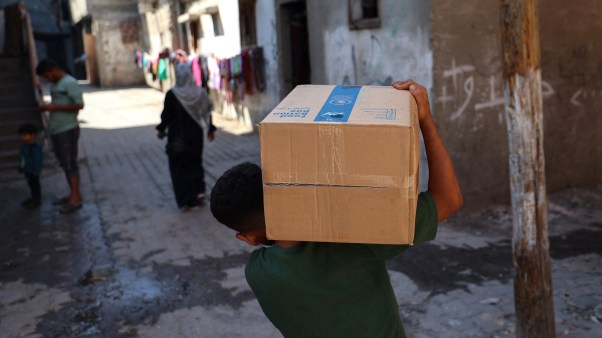A middle-level peasant probably lived in a three-bay house, the commonest type, [with three areas separate but open to each other].… Dwellings commonly still lodged animals as well as human beings, but the [barn] was more often partitioned off and sometimes positioned at right angles to the living quarters.…
Interiors were lighted by a few windows, shuttered but unglazed, and by doors, often open during the daytime, through which children and animals wandered freely. Floors were of beaten earth covered with straw or rushes. In the center, a fire of wood or of peat … burned on a raised stone hearth, vented through a hole in the roof. Some hearths were crowned by hoods or funnels to channel the smoke to the makeshift chimney, which might be capped by a barrel with its ends knocked out. The atmosphere of the house was perpetually smoky from the fire burning all day as water, milk, or porridge simmered in pots on a trivet or in footed brass or iron kettles. At night a fire-cover, a large round ceramic lid with holes, could be put over the blaze.
Trials of Domestic Life
A thirteenth-century writer, contrasting the joys of a nun’s life with the trials of marriage, pictured the domestic crisis of a wife who hears her child scream and hastens into the house to find “the cat at the bacon and the dog at the hide. Her cake is burning on the [hearth] stone, and her calf is licking up the milk. The pot is boiling over into the fire, and the churl her husband is scolding. ”
Medieval sermons, too, yield a glimpse of peasant interiors: the hall “black with smoke,” the cat sitting by the fire and often singeing her fur, the floor strewn with green rushes and sweet flowers at Easter, or straw in winter. They picture the housewife at her cleaning: “She takes a broom and drives all the dirt of the house together; and, lest the dust rise … she casts it with great violence out of the door.” But the work is never done: “For, on Saturday afternoon, the servants shall sweep the house and cast all the dung and the filth behind the door in a heap. But what then? Come the capons and the hens and scrape it around and make it as ill as it was before.” We see the woman doing laundry, soaking the clothes in lye (homemade with ashes and water), beating and scrubbing them, and hanging them up to dry. The dog, driven out of the kitchen with a basinful of hot water, fights over a bone, lies stretched in the sun with flies settling on him, or eagerly watches people eating until they throw him a morsel, “whereupon he turns his back.”
Around the Dinner Table
The family ate seated on benches or stools at a trestle table, disassembled at night. Chairs were rarities. A cupboard or hutch held wooden and earthenware bowls, jugs, and wooden spoons. Hams, bags, and baskets hung from the rafters, away from rats and mice. Clothing, bedding, towels, and table linen were stored in chests. A well-to-do peasant might own silver spoons, brass pots, and pewter dishes.
When they bathed, which was not often, medieval villagers used a barrel with the top removed. To lighten the task of carrying and heating water, a family probably bathed serially in the same water.
At night, the family slept on straw pallets, either on the floor of the hall or in a loft at one end, gained by a ladder. Husband and wife shared a bed, sometimes with the baby, who alternatively might sleep in a cradle by the fire.
What They Ate—And Didn’t
The thirteenth-century villager’s aim was not exactly self-sufficiency, but self-supply of the main necessities of life. These were bread, pottage or porridge, and ale.… In spring and summer a variety of vegetables was available: cabbage, lettuce, leeks, spinach, and parsley.… Nuts, berries, and roots were gathered in the woods.… Except for poisonous or very bitter plants, “anything that grew went into the pot, even primrose and strawberry leaves.” The pinch came in the winter and early spring, when the grain supply ran low and wild supplements were not available.
Stronger or weaker, more flavorful or blander, the pottage kettle supplied many village families with their chief sustenance. If possible, every meal including breakfast was washed down with weak ale, home-brewed or purchased from a neighbor, but water often had to serve.
The most serious shortage was protein.… Besides the shortage of protein, medieval diets were often lacking in lipids, calcium, and vitamins A, C, and D.… It was a hungry world, made hungrier by intermittent crop failures.…
What Peasants Wore
[Peasant men wore] a short tunic, belted at the waist, and either short stockings that ended just below the knee or long hose fastened at the waist to a cloth belt. A hood or cloth cap, thick gloves or mittens, and leather shoes with heavy wooden soles completed the costume.
The women wore long loose gowns belted at the waist, sometimes sleeveless tunics with a sleeved undergarment.… Underclothing, when it was worn, was usually of linen, outer garmeets were woolen.
A poor peasant’s garb … might resemble that of the poor man in Langland’s fourteenth-century allegory, Piers Plowman, whose … hair stuck through the holes in his hood and whose toes stuck through those in his heavy shoes, whose hose hung loose, whose rough mittens had worn-out fingers covered with mud, and who was himself “all smeared with mud as he followed the plow,” while beside him walked his wife carrying the goad, in a tunic tucked up to her knees, wrapped in a winnowing sheet to keep out the cold, her bare feet bleeding from the icy furrows.
The Wedding Day
Peasant couples usually spoke their vows at the church door, the most public place in the village. Here the priest inquired whether there were any impediments, meaning kinship in a degree forbidden by the church. The bridegroom named the dower [dowry] which he would provide for his wife, giving her as a token a ring and a small sum of money to be distributed to the poor. The ring, according to a fourteenth-century preacher, must be “put and set by the husband upon the fourth finger of the woman, to show that a true love and cordial affection be between them, because, as doctors say, there is a vein coming from the heart of a woman to the fourth finger, and therefore the ring is put on the same finger, so that she should keep unity and love with him, and he with her. ”
Vows were then exchanged, and the bridal party might proceed into the church, where a nuptial Mass was celebrated.… The ceremony was usually followed by a feast, a “bride ale,” in a private house or a tavern …
Birth and Baptism
In the village as in castle and city, babies were born at home, their birth attended by midwives. Men were excluded from the lying-in chamber. Literary evidence suggests that the woman in labor assumed a sitting or crouching position. Childbirth was dangerous for both mother and child. The newborn infant was immediately prepared for baptism, lest it die in a state of original sin. If a priest could not be located in time, someone else must perform the ceremony, a contingency for which water must be kept ready. If the baptizer did not know the formula in Latin, he must say it in English or French: “I christen thee in the name of the Father and the Son and the Holy Ghost. Amen.” …
Under normal circumstances the child was washed and sometimes (though not universally) swaddled, the godparents were summoned, and godmother or midwife carried the baby to the church, where the font was kept ever ready. The mother was not present, and in fact was not permitted to enter the church until several weeks later, when she had undergone the ritual of “churching,” purification after childbirth.
Preliminary baptismal rites were performed, as in marriage, at the church door. The priest blessed the child, put salt in its mouth to symbolize wisdom and exorcise demons, read a Bible text, and ascertained the child’s name and the godparents’ qualifications. The party then moved into the church to the baptismal font. The child was immersed, the godmother dried it and dressed it in a christening garment, and the priest anointed it with holy oil. The ceremony was completed at the altar with the godparents making the profession of faith for the child.
The christening party then repaired to the parents’ house for feasting.…
Rearing Children
Unlike the lady of the castle or many city women, the peasant mother normally nursed her own children. Only if the mother had no milk, or if she died, was a wet nurse employed. The evidence of the coroners’ rolls indicates that during the first year of life, infants were frequently left alone in the house while their parents worked in the fields, looked after the animals, or did other chores. Older children were more likely to be left with a sitter, usually a neighbor or a young girl.…
A fourteenth-century sermon pictures a mother and her child: “In winter, when the child’s hands are cold, the mother takes him a straw or a rush and bids him warm it, not for love of the straw, to warm it, but to warm the child’s hands [by pressing them together].” When the child falls ill, “the mother for her sick child takes a candle, and makes a vow in prayers.”
Small children played; older ones did chores. In their teens, both boys and girls moved into the adult work world, the girls in and around the house, the boys in the fields.
Sickness and Death
The Middle Ages produced the world’s first hospitals and medical schools, but these important advances hardly affected life in the village. Doctors practiced in city and in court. Villagers were left to their own medical devices. Even the barbers who combined shaving with bloodletting (a principal form of therapy) and toothpulling (the sole form of dentistry) were rarely seen in villages.…
Life was short. Even if a peasant survived infancy and childhood to reach the age of 20, he could not expect to live much beyond 45, when old age (senectus) began.…
When death was imminent, the priest was sent for, and arrived wearing surplice and stole, carrying the blessed sacrament, preceded by a server carrying a lantern and ringing a hand bell.…
Village funerals were usually starkly simple. The body, sewed in a shroud, was carried into the church on a bier, draped with a black pall. Mass was said, and occasionally a funeral sermon was delivered. One in John Myrc’s collection, Festiall, ends: “Good men, as ye all see, here is a mirror to us all: a corpse brought to the church. God have mercy on him, and bring him into his bliss that shall last for ever.… Wherefore each man and woman that is wise, make him ready thereto; for we all shall die, and we know not how soon.”
A villager was buried in a plain wooden casket or none at all, in the churchyard, called the “cemetery,” from coemeterium (dormitory), the sleeping place of the Christian dead. Here men and women could slumber peacefully, their toil finished, until the day of resurrection.
Frances and Joseph Gies are the authors of many hooks on the Middle Ages including Life in a Medieval Village (Harper & Row 1990) from which this article is excerpted by permission.
Copyright © 1991 by the author or Christianity Today/Christian History magazine.Click here for reprint information on Christian History.










